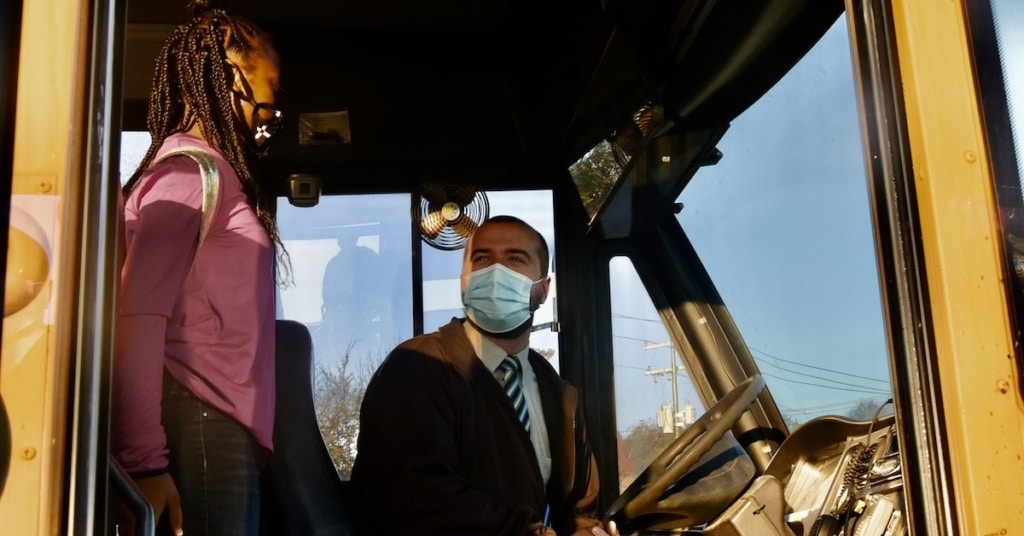Music teacher Tyler Casey typically walks into his Martin Luther King Jr. Elementary School classroom a few minutes after 7 a.m. But that’s not the start of his workday. Casey also drives a bus for Christian County Public Schools. He’s behind the wheel by 6:20 every morning to run a route for MLK students who live along Russellville Road.
Casey is one of six non-traditional bus drivers currently on double-duty for the school system. Five are teachers, and one is a custodian.
They are part of the solution to a bus driver shortage affecting Christian County and districts across the country.
The driver shortage isn’t a new problem, but the coronavirus pandemic was a “perfect storm” that escalated the challenge of staffing 96 bus routes in Christian County, said Mike Brumley, who has been director of the transportation department for 12 years.

“Over the last several years, it has been increasingly hard to recruit and retain drivers and monitors, then throw COVID on top of that, and the school district has not fared well,” Brumley told Hoptown Chronicle.
The district pays drivers $14.35 an hour — up $2 an hour with a raise that was approved in the fall of 2020. Drivers also qualify for an incentive package for attendance and safety records. Monthly bonuses for drivers who do not miss a day of work or have an accident where the driver is at fault add up to $2,000 a year. The most common accident is hitting a mailbox, and last year there were only 15 accidents in which the driver was at fault, according to Brumley.
Full-time drivers, those working at least four hours a day, have a benefits package that includes health insurance, a $20,000 life insurance policy and retirement benefits.
The district is constantly recruiting drivers, especially at kindergarten registration where parents learn they can have the same schedule as their children if they drive a bus.
Brumley, who has 30 years of experience in pupil transportation, said he has been able to reduce the number of bus routes in Christian County from 114 to 96. He said he tries to “just route smarter,” which also reduces the number of drivers the district needs to hire.
Still, it takes a large contingent to staff the 96 routes. Each school day, 100 people drive a bus route, some driving just a morning or afternoon route. All the routes are at least two hours and 30 minutes long, and most drivers are behind the wheel six to seven hours a day. Routes average 75 miles twice a day, and the district’s buses log more than 2 million miles a year, said Brumley.
When the pandemic forced the district to close classrooms and switch to virtual learning in the spring of 2020, Brumley was able to keep all of the district’s drivers working by delivering meals from school cafeterias to students. He said he was proud that “no one lost a paycheck.”
With school back in session and buses running their regular routes, the district is down about 10% for full-time drivers and permanent subs. That’s where employees like Casey, the MLK music teacher, help fill gaps. In addition to the five teachers and one custodian currently driving, there are another 18 assistant principals and teachers now certified to drive a bus if Brumley needs to call on them.
There are several requirements to obtain the Class B CDL license for a bus driver.
A driver must be at least 21 years old, pass a background check and have a five-year clean driving record, with no offenses for DUI or reckless driving.
The applicant must pass a physical exam and then take a general knowledge test and a CDL test. The district covers the expenses.
When applicants pass all the exams, they receive a permit to begin training.
The Kentucky Department of Education requires 21 hours of classroom and behind-the-wheel training, but Brumley and his staff provide more than 50 hours of training.
The time from application to driving a bus takes three to four weeks, but some factors can slow the process. The turnaround time for the application to clear KDE is currently three to four days; previously it took only one day. Additionally, some applicants take the required tests more than once, and some need more behind-the-wheel training.
Brumley said it takes a special person to drive a bus.
“They have to love kids,” he said, adding bus drivers need to be good communicators and build relationships with students and parents. Along with being patient, they must be mediators, counselors and disciplinarians with as many as 78 elementary students, or 60 middle and high school students, in one bus, all while keeping their eyes on the road.
Brumley, who drove a bus when he started his teaching career in Adair County, likes having teachers as bus drivers — as long as their principals are OK with the extra work.
“Having a teacher as a bus driver helps build a stronger relationship with the students,” he said. “The teacher gets to know them and their family better. They see where they live.”
Casey agreed, saying, “There is a stronger connection with students and families. I can talk with the parents when they meet the bus. I let students off the bus, and 20 minutes later, they are in my class. I like it.”
Jim Gardner, who started driving a bus five years ago, said it was the perfect opportunity for him after retiring from running Haddock’s Grocery. He said he gets excellent health insurance, but there are other benefits, he said.
“I love it. I have a great route with Sinking Fork Elementary. It gives me flexibility during my day, and I’m a people person and enjoy the children and parents. I also like to think I’m giving back to the community,” he said.
Toni Wilson Riley is a freelance writer and a retired Christian County Cooperative Extension 4-H Youth Development agent. She lives in Hopkinsville on a small goat farm.






